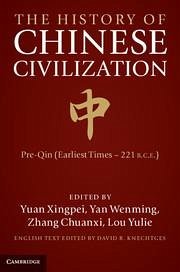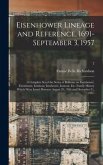The History of Chinese Civilisation 4 Volume Set
Herausgeber: Yuan, Xingpei; Knechtges, David R; Lou, Yulie; Zhang, Chuanxi; Yan, Wenming / Übersetzer: Knechtges, David R
The History of Chinese Civilisation 4 Volume Set
Herausgeber: Yuan, Xingpei; Knechtges, David R; Lou, Yulie; Zhang, Chuanxi; Yan, Wenming / Übersetzer: Knechtges, David R
- Broschiertes Buch
- Merkliste
- Auf die Merkliste
- Bewerten Bewerten
- Teilen
- Produkt teilen
- Produkterinnerung
- Produkterinnerung
A comprehensive, illustrated history of Chinese civilisation from Neolithic times to 1911 by the foremost Chinese scholars of their generation.
Andere Kunden interessierten sich auch für
![The Cambridge History of the Cold War 3 Volume Set The Cambridge History of the Cold War 3 Volume Set]() The Cambridge History of the Cold War 3 Volume Set131,99 €
The Cambridge History of the Cold War 3 Volume Set131,99 €![The Cambridge History of Turkey 4 Volume Hardback Set The Cambridge History of Turkey 4 Volume Hardback Set]() The Cambridge History of Turkey 4 Volume Hardback Set933,99 €
The Cambridge History of Turkey 4 Volume Hardback Set933,99 €![The Cambridge History of Ireland 4 Volume Hardback Set The Cambridge History of Ireland 4 Volume Hardback Set]() The Cambridge History of Ireland 4 Volume Hardback Set573,99 €
The Cambridge History of Ireland 4 Volume Hardback Set573,99 €![Eisenhower Lineage and Reference, 1691-September 3, 1957; a Complete Set of the Series of Bulletins on Eisenhower, Eisenhauer, Isenhour, Icenhower, Izanour, Etc. Family History Which Were Issued Between August 20, 1956 and December 31, 1957.; 2 Eisenhower Lineage and Reference, 1691-September 3, 1957; a Complete Set of the Series of Bulletins on Eisenhower, Eisenhauer, Isenhour, Icenhower, Izanour, Etc. Family History Which Were Issued Between August 20, 1956 and December 31, 1957.; 2]() Eisenhower Lineage and Reference, 1691-September 3, 1957; a Complete Set of the Series of Bulletins on Eisenhower, Eisenhauer, Isenhour, Icenhower, Izanour, Etc. Family History Which Were Issued Between August 20, 1956 and December 31, 1957.; 243,99 €
Eisenhower Lineage and Reference, 1691-September 3, 1957; a Complete Set of the Series of Bulletins on Eisenhower, Eisenhauer, Isenhour, Icenhower, Izanour, Etc. Family History Which Were Issued Between August 20, 1956 and December 31, 1957.; 243,99 €![The Civilisation of the Renaissance in Italy The Civilisation of the Renaissance in Italy]() Jacob BurckhardtThe Civilisation of the Renaissance in Italy29,99 €
Jacob BurckhardtThe Civilisation of the Renaissance in Italy29,99 €![The Collapse of Western Civilisation The Collapse of Western Civilisation]() Janusz MeyerhoffThe Collapse of Western Civilisation11,99 €
Janusz MeyerhoffThe Collapse of Western Civilisation11,99 €![General History of Civilisation in Europe, From the Fall of the Roman Empire Till the French Revolution. A Treatise on Death Punishments. General History of Civilisation in Europe, From the Fall of the Roman Empire Till the French Revolution. A Treatise on Death Punishments.]() François GuizotGeneral History of Civilisation in Europe, From the Fall of the Roman Empire Till the French Revolution. A Treatise on Death Punishments.25,99 €
François GuizotGeneral History of Civilisation in Europe, From the Fall of the Roman Empire Till the French Revolution. A Treatise on Death Punishments.25,99 €-
-
-
A comprehensive, illustrated history of Chinese civilisation from Neolithic times to 1911 by the foremost Chinese scholars of their generation.
Hinweis: Dieser Artikel kann nur an eine deutsche Lieferadresse ausgeliefert werden.
Hinweis: Dieser Artikel kann nur an eine deutsche Lieferadresse ausgeliefert werden.
Produktdetails
- Produktdetails
- Verlag: Cambridge University Press
- Seitenzahl: 2000
- Erscheinungstermin: 28. Mai 2012
- Englisch
- Abmessung: 260mm x 182mm x 193mm
- Gewicht: 5529g
- ISBN-13: 9781107013094
- ISBN-10: 1107013097
- Artikelnr.: 34963881
- Herstellerkennzeichnung
- Libri GmbH
- Europaallee 1
- 36244 Bad Hersfeld
- gpsr@libri.de
- Verlag: Cambridge University Press
- Seitenzahl: 2000
- Erscheinungstermin: 28. Mai 2012
- Englisch
- Abmessung: 260mm x 182mm x 193mm
- Gewicht: 5529g
- ISBN-13: 9781107013094
- ISBN-10: 1107013097
- Artikelnr.: 34963881
- Herstellerkennzeichnung
- Libri GmbH
- Europaallee 1
- 36244 Bad Hersfeld
- gpsr@libri.de
Volume I. Earliest Times - 221 BCE: Preface
General introduction
Introduction
1. The dawn of Chinese civilization
2. The beginnings of Chinese civilization
3. The flourishing of civilization in the Shang and Zhou
4. Brilliant bronze culture
5. The application and production of bronze
6. Capitals, cities and commerce of the Shang and Zhou
7. The origins and early development of Chinese script
8. Religion and belief in the Shang and Zhou periods
9. The development of education and the flourishing of scholarship
10. The birth of Chinese literature and art. Volume II. Qin, Han, Wei, Jin, and the Northern and Southern Dynasties: Preface
Introduction
1. Creation and development of a multiethnic centralized state
2. The establishment and transformation of bureaucratic government
3. Growth of the feudal economy
4. The position and evolution of Ruist learning
5. Abtruse learning in the Wei and Jin dynasties
6. The introduction of Buddhism and the appearance of Daoism
7. The foundation and development of historiography and geography
8. Literature of the Qin, Han, Wei and Northern and Southern dynasties
9. The full flourishing of the Arts
10. Systemization of science and technology
11. Social life. Volume III. Sui and Tang to mid-Ming Dynasties (581-1525): Preface
Introduction
1. Fusion of southern and northern cultures and unification of the empire
2. The silk road and cultural exchange between China and foreign lands
3. Economic prosperity and the shift of the economic center of gravity to the south
4. The development of the civil service examination system and the rise of the new literati class
5. The perfection of the civil official system
6. Ruism and new developments in religion
7. The expansion of scholarship and the florescence of education
8. The evolution of the northern peoples and their contribution to Chinese civilization
9. A new period in the history of Chinese-foreign relations
10. Science and technology and the development of the concept of science
11. The downward movement of literature and its full florescence
12. Artistic style and the spirit of the times
13. Social life. Volume IV. Late Ming and Qing Dynasties (1525-1911): Preface
Introduction
1. Economic development
2. Proto-enlightenment trends and new elements in political culture
3. Science and technology
4. The establishment and growth of a multiethnic state
5. Political development and people's livelihood
6. Cultural awareness and achievement in the early and mid-Qing dynasty
7. The eastward flow of western learning and the spread of Chinese civilization
8. Religious belief: concepts and practice
9. New directions in literature and the arts
10. Order and disruption in social life
11. Education in schools and in society
12. The building of core cities and the emergence of regional differences
13. The push for reform: the birth of modern culture.
General introduction
Introduction
1. The dawn of Chinese civilization
2. The beginnings of Chinese civilization
3. The flourishing of civilization in the Shang and Zhou
4. Brilliant bronze culture
5. The application and production of bronze
6. Capitals, cities and commerce of the Shang and Zhou
7. The origins and early development of Chinese script
8. Religion and belief in the Shang and Zhou periods
9. The development of education and the flourishing of scholarship
10. The birth of Chinese literature and art. Volume II. Qin, Han, Wei, Jin, and the Northern and Southern Dynasties: Preface
Introduction
1. Creation and development of a multiethnic centralized state
2. The establishment and transformation of bureaucratic government
3. Growth of the feudal economy
4. The position and evolution of Ruist learning
5. Abtruse learning in the Wei and Jin dynasties
6. The introduction of Buddhism and the appearance of Daoism
7. The foundation and development of historiography and geography
8. Literature of the Qin, Han, Wei and Northern and Southern dynasties
9. The full flourishing of the Arts
10. Systemization of science and technology
11. Social life. Volume III. Sui and Tang to mid-Ming Dynasties (581-1525): Preface
Introduction
1. Fusion of southern and northern cultures and unification of the empire
2. The silk road and cultural exchange between China and foreign lands
3. Economic prosperity and the shift of the economic center of gravity to the south
4. The development of the civil service examination system and the rise of the new literati class
5. The perfection of the civil official system
6. Ruism and new developments in religion
7. The expansion of scholarship and the florescence of education
8. The evolution of the northern peoples and their contribution to Chinese civilization
9. A new period in the history of Chinese-foreign relations
10. Science and technology and the development of the concept of science
11. The downward movement of literature and its full florescence
12. Artistic style and the spirit of the times
13. Social life. Volume IV. Late Ming and Qing Dynasties (1525-1911): Preface
Introduction
1. Economic development
2. Proto-enlightenment trends and new elements in political culture
3. Science and technology
4. The establishment and growth of a multiethnic state
5. Political development and people's livelihood
6. Cultural awareness and achievement in the early and mid-Qing dynasty
7. The eastward flow of western learning and the spread of Chinese civilization
8. Religious belief: concepts and practice
9. New directions in literature and the arts
10. Order and disruption in social life
11. Education in schools and in society
12. The building of core cities and the emergence of regional differences
13. The push for reform: the birth of modern culture.
Volume I. Earliest Times - 221 BCE: Preface
General introduction
Introduction
1. The dawn of Chinese civilization
2. The beginnings of Chinese civilization
3. The flourishing of civilization in the Shang and Zhou
4. Brilliant bronze culture
5. The application and production of bronze
6. Capitals, cities and commerce of the Shang and Zhou
7. The origins and early development of Chinese script
8. Religion and belief in the Shang and Zhou periods
9. The development of education and the flourishing of scholarship
10. The birth of Chinese literature and art. Volume II. Qin, Han, Wei, Jin, and the Northern and Southern Dynasties: Preface
Introduction
1. Creation and development of a multiethnic centralized state
2. The establishment and transformation of bureaucratic government
3. Growth of the feudal economy
4. The position and evolution of Ruist learning
5. Abtruse learning in the Wei and Jin dynasties
6. The introduction of Buddhism and the appearance of Daoism
7. The foundation and development of historiography and geography
8. Literature of the Qin, Han, Wei and Northern and Southern dynasties
9. The full flourishing of the Arts
10. Systemization of science and technology
11. Social life. Volume III. Sui and Tang to mid-Ming Dynasties (581-1525): Preface
Introduction
1. Fusion of southern and northern cultures and unification of the empire
2. The silk road and cultural exchange between China and foreign lands
3. Economic prosperity and the shift of the economic center of gravity to the south
4. The development of the civil service examination system and the rise of the new literati class
5. The perfection of the civil official system
6. Ruism and new developments in religion
7. The expansion of scholarship and the florescence of education
8. The evolution of the northern peoples and their contribution to Chinese civilization
9. A new period in the history of Chinese-foreign relations
10. Science and technology and the development of the concept of science
11. The downward movement of literature and its full florescence
12. Artistic style and the spirit of the times
13. Social life. Volume IV. Late Ming and Qing Dynasties (1525-1911): Preface
Introduction
1. Economic development
2. Proto-enlightenment trends and new elements in political culture
3. Science and technology
4. The establishment and growth of a multiethnic state
5. Political development and people's livelihood
6. Cultural awareness and achievement in the early and mid-Qing dynasty
7. The eastward flow of western learning and the spread of Chinese civilization
8. Religious belief: concepts and practice
9. New directions in literature and the arts
10. Order and disruption in social life
11. Education in schools and in society
12. The building of core cities and the emergence of regional differences
13. The push for reform: the birth of modern culture.
General introduction
Introduction
1. The dawn of Chinese civilization
2. The beginnings of Chinese civilization
3. The flourishing of civilization in the Shang and Zhou
4. Brilliant bronze culture
5. The application and production of bronze
6. Capitals, cities and commerce of the Shang and Zhou
7. The origins and early development of Chinese script
8. Religion and belief in the Shang and Zhou periods
9. The development of education and the flourishing of scholarship
10. The birth of Chinese literature and art. Volume II. Qin, Han, Wei, Jin, and the Northern and Southern Dynasties: Preface
Introduction
1. Creation and development of a multiethnic centralized state
2. The establishment and transformation of bureaucratic government
3. Growth of the feudal economy
4. The position and evolution of Ruist learning
5. Abtruse learning in the Wei and Jin dynasties
6. The introduction of Buddhism and the appearance of Daoism
7. The foundation and development of historiography and geography
8. Literature of the Qin, Han, Wei and Northern and Southern dynasties
9. The full flourishing of the Arts
10. Systemization of science and technology
11. Social life. Volume III. Sui and Tang to mid-Ming Dynasties (581-1525): Preface
Introduction
1. Fusion of southern and northern cultures and unification of the empire
2. The silk road and cultural exchange between China and foreign lands
3. Economic prosperity and the shift of the economic center of gravity to the south
4. The development of the civil service examination system and the rise of the new literati class
5. The perfection of the civil official system
6. Ruism and new developments in religion
7. The expansion of scholarship and the florescence of education
8. The evolution of the northern peoples and their contribution to Chinese civilization
9. A new period in the history of Chinese-foreign relations
10. Science and technology and the development of the concept of science
11. The downward movement of literature and its full florescence
12. Artistic style and the spirit of the times
13. Social life. Volume IV. Late Ming and Qing Dynasties (1525-1911): Preface
Introduction
1. Economic development
2. Proto-enlightenment trends and new elements in political culture
3. Science and technology
4. The establishment and growth of a multiethnic state
5. Political development and people's livelihood
6. Cultural awareness and achievement in the early and mid-Qing dynasty
7. The eastward flow of western learning and the spread of Chinese civilization
8. Religious belief: concepts and practice
9. New directions in literature and the arts
10. Order and disruption in social life
11. Education in schools and in society
12. The building of core cities and the emergence of regional differences
13. The push for reform: the birth of modern culture.








